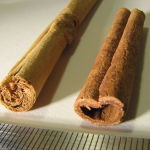by Cat, May 31, 2016 (Images from Wikimedia Commons: Cardamom, right, and Cinnamon, below)
Yogi tea is centuries old custom in India, that inspired the modern Chai. But there is a big difference between the two: yogi tea is mostly spices in milk with a tiny bit of black tea; chai has fewer of the health-boosting spices and a lot more black tea.
I first had real Yogi tea at a small espresso shop in Eugene OR in the 1970s – before I developed a taste for espresso. I loved the warm spicy flavors, and how it warmed my soul. But I never learned how to make it.
Then, today, I got an email from Learning Herbs, with a link to a video on making Yogi Tea, with renowned Ayurvedic herbalist K. P. Khalsa as the instructor. I can’t wait to make it. As you read the recipe, the amount of each of the spices may seem daunting, but you don’t grind up the spices; instead, you let their essences steep in the simmering water. Plus, it makes 4 cups of the tea.
See also: 1. Herbs & Spices (About) Menu; 2. Ancient Medicine Through Food
Homemade Yogi Tea
This recipe is from K.P. Khalsa and Learning Herbs (1). I’ve not adapted it other than to suggest:
- Using filtered water;
- Using only Organic spices and black tea;
- If you cannot have dairy,try either almond or cashew milk. Another option is to make your own coconut milk from fresh coconut (commercial coconut milks are overly diluted and lack much of the goodness of the coconut);
- If you use dairy milk, your best options are raw or simply pasteurized. I do not recommend ultra-pasteurized milk, which is the most common dairy milk in grocery stores. Here in the Flathead Valley of Montana, we are fortunate to have Kalispell Creamery; those in the Bitterroot and Missoula valleys have Lifeline Dairy. Both of these local dairies use simple pasteurization (HTST). See Food Safety and Pasteurization (printable pdf file) for more on the different types of pasteurization)
See Learning Herbs video (1) for more detail about the spices and the recipe.
In the video, K.P. Khalsa explains that Yogi Tea provides the following health benefits, making it a good snack between meals:
- Warming
- Enhances digestion
- Increases circulation
- Pumps up the immune system
The recipe
- 2 sticks Organic cinnamon
- 16 pods Organic cardamom (do not remove seeds from the pods)
- 12 whole Organic cloves
- 24 Organic black peppercorns
- 4 slices Organic ginger root (unpeeled)
- 40 oz (5 cups) filtered water
- 1 tsp Organic black tea (bulk, not in a tea bag)
- 2 cups whole raw or simply pasteurized milk
- raw local honey, to taste
- Combine the cinnamon, cardamom, cloves, peppercorns and ginger root in a pot or saucepan, with filtered water.
- Bring to a boil, then reduce heat and simmer 20 minutes..
- Add 1 tsp black tea (bulk) toward the end of the simmer, and let it blend in.
- Add 2 cups milk and heat just to the point where the milk begins to scald (steam begins to gather above the pan and tiny bubbles of milk appear at the edges). DO NOT BOIL!
- Immediately remove from heat and pour through a mesh strainer into a bowl. Discard/compost what remains in the strainer.
- Add honey, to taste, to the milky mixture and serve.
References:
- Learning Herbs video & recipe: explore.learningherbs.com/culinary-herbalism/traditional-yogi-tea/


